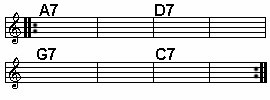Scroll through the lesson and click on notation/video/audio links to load the interactive players.
Please subscribe to get full access to all lessons for only $7.95/month PLUS 1 week free trial.

Riff Interactive lessons are
LESS expensive and
MORE interactive than alternatives!
More Info
|
|

Jazz Guitar For
Beginners
Lesson 4
Lyle:
This lesson is about playing a melody or improvising over a chord progression
that keeps changing in different keys.
Lyle: In the last lesson you learned this 8 bar
progression:
chord
chart

Lyle: Each of these chords are in a different key
because they are all dominant chords. And each of these dominant chords are the
5th chord of a key.
Lyle: So you'll need to switch keys for each
chord. I'm going to show you a few simple ideas to help you be able to find your
own way to play against typical chord changes like this found in
jazz.
Lyle: Here's the looping jam track for this
lesson:
Lyle:
This follows the chord chart above, same as last lesson.
Lyle: One of the best ways to play a melody
against this chord progression is to use arpeggios.
Lyle: An arpeggio is the notes of a chord played
one at a time, melodically, instead of all at once
harmonically.
Lyle: Learn this A7 arpeggio shape to play
against the first A7 chord:
Lyle:
Now you can transpose this arpeggio and it's finger pattern up the neck to the
10th fret and play a D7 arpeggio, need for the D7 chord in the
progression:
Lyle:
Just train your fingers to play this arpeggio shape forwards and backwards. You
can use it for any dominant chord.
Lyle: Play it down low on the 3rd fret to get the
G7 chord arpeggio:
Lyle: C7
would start on the 8th fret like this:
jeff: These are
a little different than the standard arpeggio's aren't
they?
Lyle: Standard, as in Major? Yes. These are
dominant 7 arpeggios, made from the root, 3, 5, and b7 degrees of the Major
scale. These intervals make up the dom7 chord.
Lyle: Now the fun part. Try playing the correct
arpeggio for each chord in the progression, like this:
Lyle:
Remember, you're playing A7 to D7, G7 to
C7.
Lyle:
Play along with the TAB notation, click loop, or try playing along to the
looping jam track.
Lyle: Here's another exercise using these very
same arpeggios but this time played twice as fast:
Lyle:
That takes a little extra concentration to play exercise
2.
Lyle:
Another thing you can easily play for each chord is a Major blues scale, made
from the root, 2, b3, 3, 5, and 6 degrees of the major
scale.
Lyle: For each dominant chord you can play its
own major blues scale. I'll show you one pattern for the A7 chord, then just
shift it to the correct starting points for each other chord, like
this:
Lyle:
Now put them in order against the jam track like this:
radica: It
sounds cool when you alternate them as
well!
Lyle: I'm just showing you one way to play them,
there are many other patterns and rhythmic possibilities
Lyle: Yes, try mixing up the use of the arpeggios
and Major blues scales. Here's an example that starts with G7 arpeggio, to D
Major blues, to G7 arpeggio, to C7 Major blues:
Lyle:
Now try reversing that. Start with A Major blues, to D7 arpeggio, to G Major
blues, to C7 arpeggio:
Lyle:
These are all V chords.
Lyle:
Another thing you can do is play a cool riff and transpose it for each chord.
Here's a little riff for the A7 chord that is made from the A7 arpeggio. It has
a chromatic walk up in it:
Lyle:
Notice I've added a little vibrato to the second to the last note of the riff
too.
Lyle: Now try playing this riff for each chord
like this:
Lyle:
Now you have several ideas to use when playing over a series of dominant chords.
Practice all the exercises in this lesson until you are able to play them
easily.
|
<< load notation from left
|
|
<< load audio from left
|
<< load audio from left
|